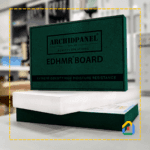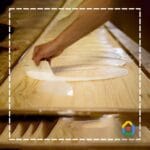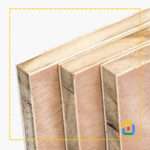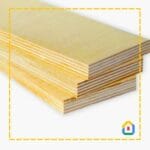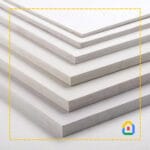India’s diverse climate, from scorching summers to monsoon rains, places high demands on construction materials, especially for outdoor applications. Exterior Grade Plywood has emerged as a formidable solution to withstand these challenges while providing strength and durability. In this comprehensive guide, we will delve into the world of Exterior Grade Plywood in India, uncovering its characteristics, applications, grades, advantages, and much more.
Understanding Exterior Grade Plywood
What is Exterior Grade Plywood?
Exterior Grade Plywood, also known as “Ext. Plywood” or “Exterior Plywood,” is a type of plywood specifically designed for outdoor use. It is engineered to withstand moisture, humidity, temperature variations, and other environmental factors that can cause standard plywood to deteriorate when exposed to the elements. Exterior Grade Plywood is highly valued for its ability to maintain structural integrity and resist damage in outdoor settings.
Composition
Exterior Grade Plywood is crafted using the same fundamental principles as standard plywood, with a few key differences in its composition to enhance its durability and resistance to environmental stressors. The primary components of Exterior Grade Plywood include:
- Veneer Sheets: Thin wood veneer sheets make up the layers of Exterior Grade Plywood. These veneers are typically sourced from various wood species, including hardwoods like birch or tropical woods like Gurjan.
- Waterproof Glue: The veneer sheets are bonded together using waterproof adhesive, such as phenol-formaldehyde resin, to create a strong and moisture-resistant composite material.
- Preservative Treatment: In some cases, Exterior Grade Plywood may undergo preservative treatment to enhance its resistance to decay, insects, and fungal growth.
Manufacturing Process
The production of Exterior Grade Plywood involves a meticulous manufacturing process to ensure its durability and resistance to environmental factors:
- Veneer Selection: High-quality veneer sheets are carefully selected based on their strength, durability, and resistance to moisture.
- Gluing: The veneer sheets are coated with waterproof adhesive to create a moisture-resistant bond between the layers.
- Layer Arrangement: The veneer sheets are stacked in a specific arrangement to ensure even distribution of stress and minimize the risk of warping or delamination.
- Pressing: The veneer stack is placed in a hydraulic press, where it undergoes pressure and heat to activate the adhesive and create a solid plywood panel.
- Cutting and Finishing: Once the Exterior Grade Plywood sheets are formed, they are cut to size, sanded for a smooth finish, and trimmed to remove any defects.
Grades of Exterior Grade Plywood
Exterior Grade Plywood is available in different grades, each indicating its resistance to environmental factors and suitability for specific applications. In India, the commonly used Exterior Grade Plywood grades include:
1. BWR Grade (Boiling Water Resistant)
BWR Grade Exterior Plywood is designed to withstand exposure to moisture, making it suitable for outdoor use. It is often used in applications where occasional contact with water is expected, such as exterior doors and window frames. BWR plywood should not delaminate or lose its structural integrity when exposed to moisture.
2. BWP Grade (Boiling Water Proof)
BWP Grade Exterior Plywood offers the highest level of water resistance. It can endure prolonged exposure to water and harsh weather conditions without delaminating or deteriorating. BWP plywood is commonly used in marine applications, such as boat building, as well as for outdoor structures like garden furniture and outdoor cabinets.
3. Marine Grade
Marine Grade Exterior Plywood is engineered for the most demanding outdoor environments. It is not only highly resistant to water but also capable of withstanding saltwater exposure, making it suitable for marine applications. Marine plywood is used extensively in boat construction, where durability and water resistance are critical.
4. Commercial Grade
Commercial Grade Exterior Plywood is a more basic and affordable option for outdoor use. While it may not have the same level of water resistance as BWR, BWP, or Marine Grade plywood, it is still suitable for applications like temporary outdoor structures, packaging, and similar uses.
Advantages of Exterior Grade Plywood
Exterior Grade Plywood offers numerous advantages that make it an ideal choice for outdoor applications and areas exposed to the elements:
1. Durability
One of the primary advantages of Exterior Grade Plywood is its durability. It can withstand exposure to rain, sunlight, temperature fluctuations, and other environmental factors without deteriorating.
2. Water Resistance
Exterior Grade Plywood is specifically designed to resist moisture, making it suitable for outdoor use where occasional or continuous exposure to water is expected.
3. Structural Integrity
Even when exposed to environmental stressors, Exterior Grade Plywood maintains its structural integrity. It remains strong and stable over time, ensuring that it can support the intended load.
4. Versatility
Exterior Grade Plywood is highly versatile and can be used in a wide range of outdoor applications, from building facades and roofing to outdoor furniture and garden structures.
5. Resistance to Decay and Insects
The treatment and adhesive used in Exterior Grade Plywood make it resistant to decay, insect infestations, and fungal growth, ensuring its longevity.
6. Cost-Effective
Compared to solid wood or other outdoor materials, Exterior Grade Plywood is a cost-effective choice without compromising on quality.
7. Sustainability
Many Exterior Grade Plywood manufacturers in India prioritize sustainable forestry practices, ensuring a renewable and eco-friendly source of wood.
Applications of Exterior Grade Plywood
Exterior Grade Plywood is a versatile material used in a wide range of outdoor applications, including:
1. Building Facades
Exterior Grade Plywood can be used as a cladding material for building facades, adding both aesthetics and weather resistance.
2. Roofing
It is employed as roof sheathing to provide a stable and weather-resistant base for roofing materials, such as shingles or metal panels.
3. Outdoor Furniture
Exterior Grade Plywood is used to craft durable outdoor furniture, including tables, chairs, benches, and picnic tables.
4. Exterior Doors
It is a preferred material for constructing exterior doors due to its durability and resistance to moisture.
5. Window Frames
Exterior Grade Plywood can be used to make window frames and sills, ensuring they can withstand exposure to the elements.
6. Garden Structures
Outdoor structures like garden sheds, pergolas, and trellises often use Exterior Grade Plywood for their construction.
7. Outdoor Cabinetry
In outdoor kitchens and other outdoor living spaces, plywood can be used for cabinets and storage units.
8. Signage
Exterior Grade Plywood is commonly used for outdoor signage due to its ability to hold paint and resist weather-related damage.
9. Playhouses and Play Structures
It is a suitable material for building children’s playhouses, swing sets, and other outdoor play structures.
10. Fencing
Plywood panels can be used in fencing systems to create privacy screens and boundary markers.
Maintenance and Care
Proper maintenance and care can extend the lifespan of Exterior Grade Plywood and ensure that it continues to perform well in outdoor applications:
- **Regular Inspection
:** Periodically inspect Exterior Grade Plywood for signs of damage, wear, or water infiltration. Pay particular attention to edges and corners, as these areas are more vulnerable to moisture.
- Sealing and Finishing: Apply a suitable finish, such as paint, stain, or a clear sealer, to protect the plywood from moisture and UV radiation. Ensure that all edges and cut ends are adequately sealed to prevent water infiltration.
- Cleaning: Clean the surface of Exterior Grade Plywood regularly to remove dirt, debris, and mildew. Use a mild detergent and water, and avoid abrasive cleaners that may damage the finish.
- Avoid Ground Contact: Whenever possible, elevate Exterior Grade Plywood off the ground or any surface that can hold moisture, as prolonged contact with moisture can lead to decay.
- Inspect Fasteners: Check the fasteners (screws, nails, or bolts) used to secure Exterior Grade Plywood components. Ensure that they are in good condition and tighten any loose fasteners.
- Repairs: Address any damage, such as cracks, delamination, or rot, promptly. Repair or replace damaged sections to maintain the structural integrity of the plywood.
Conclusion
Exterior Grade Plywood has proven to be an indispensable material in India’s construction and design landscape. Its ability to withstand the harsh outdoor elements, coupled with its durability and versatility, makes it a top choice for a wide range of applications. Whether it’s providing a weather-resistant skin to a building or crafting durable outdoor furniture, Exterior Grade Plywood continues to play a pivotal role in shaping the country’s architectural and design projects. As India continues to develop and expand, the reliable performance of Exterior Grade Plywood ensures that structures and outdoor amenities remain robust and resilient against the forces of nature.

